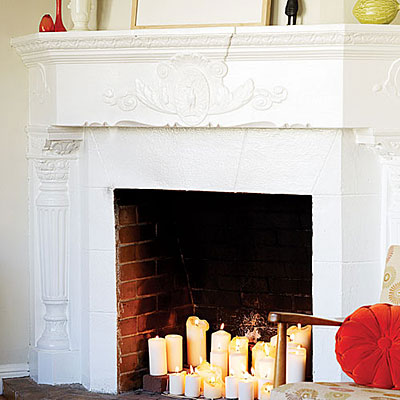|
Wednesday, July 16 2014
Just because the summer has come does not mean that you cannot use your fireplace to help improve the design of your living or family room. Here are just a couple of ways that you can take an inactive fireplace and make it into a decorative centeripiece in your home. Use it in conjunction with plants A fireplace that has a large opening and a sizable shelf above it is a prime candidate for some indoor plant life. By putting flowers or ferns on the shelf you can enjoy some color above the fireplace. This will draw attention away from the empty fireplace and give the plants prominent placement in your room design. You also have the option of putting a larger plant in the opening of the fireplace. This will eliminate the gap in the room left by a cold fireplace. Find a decorative cover Just like room dividers, tapestries, and other design pieces that can help to expand a room, a fireplace cover can be a great way to cover up a fireplace that is not in use and needs help to add to the room design. There are numerous options for a fireplace cover. Some of them are purely functional, while others can be just a nice as traditional pieces of art. Place logs or candles Just because a fireplace is not in use does not mean that it has to be empty for the entire season. You can fill a cold fireplace with attractive looking logs or candles so that it does not appear to be completely vacant. As an added bonus, by using logs you will already have a full fireplace for the first use of the next season! There are many other options such as shelving, fireplace doors, and other ways that a fireplace can still look great during the off season. Experiment and find the best options for your design goals. Good luck and thanks for reading! Tuesday, July 01 2014
With so many preparations to worry about, the last thing you may think about come winter is the condition of your fireplace and chimney. But, turning that fireplace on after months of inactivity and wear from the changing seasons could leave your house, your family, and yourself at risk. Improperly maintained chimneys can cause structural damage, destroy homes or even injure people. There are a few different signs of chimney damage you should look out for. Deterioration Years of wear and tear from Mother Nature can cause a chimney’s brick and mortar to deteriorate. Older chimney’s have not only had to endure more wear, but they may also be made of blends that are softer and more porous than those used today, which could cut the life of a chimney in half. Different climates also have different effects on the structure of a chimney. “Spalling” can occur if you live in a climate that experiences freeze/thaw cycles. Moisture enters the concrete, freezes, and expands causing pieces or layers of the brick to crumble off. Cracked Crowns A chimney crown is a concrete slab placed on top of the chimney. Its purpose is to protect the chimney from weather and prevent deterioration. If a chimney crown has shrunk or cracked, it exposes the rest of the chimney to water and other natural elements, which could cause bricks to fall out or come loose. A good quality crown should be made of concrete or cement, have no cracks, and overhang the masonry by at lease 2 inches. Broken Caps A chimney cap is a metal “hat” that protects the interior of the chimney. Caps are important to the proper functioning of a chimney since they prevent water from entering the inside of the chimney, keep animals and debris out, and allow proper venting. A broken chimney cap can have severe consequences, such as water damage to the chimney and even inside your house. If a cap is not allowing for proper venting, smoke could build up inside the chimney and enter your house, or even cause a fire. Improper Dimensions If a chimney is too short, it may fail to prevent downdrafts. The improper spacing between components can also prevent smoke from rolling before entering the smoke shelf, and allow smoke to enter your house. Poor Flashing Flashing is thin material that is installed to prevent water from entering a structure. Chimneys typically have flashing installed under the roof shingles and cut into the brickwork. Even minor breaches in flashing can lead to significant leaks and serious water damage. |
www.ChicagoChimney.com







